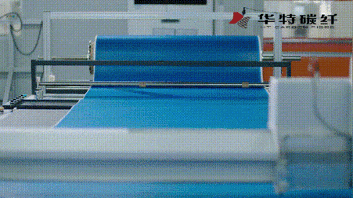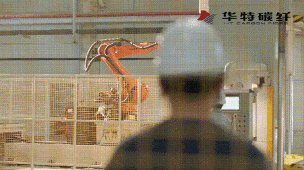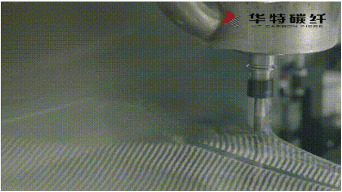An Article to Learn More About Carbon Fiber
Carbon fiber is a fiber material with a carbon content of more than 95%. It has excellent mechanical, chemical, electrical and other excellent properties. It is the “king of new materials” and a strategic material that is lacking in military and civilian development. It is very expensive and is often called “black gold”.
She is called a noble material, expensive, and worth a thousand gold. She is a weapon for speeding parties and a “dark horse” in the material industry. She is carbon fiber. What you see is the production line of carbon fiber.

China Has Completely Independently Developed a 100-ton T1000 Carbon Fiber Production Line
How is The Fine Carbon Fiber Made?
The carbon fiber production process technology has matured to this day. With the continuous development of carbon fiber composite materials, it is increasingly favored by all walks of life, especially the strong growth and driving role of aviation, automobiles, rails, wind turbine blades, etc. The development prospects of the carbon fiber industry are broader. The carbon fiber industry chain can be divided into upstream and downstream. The upstream usually refers to the production of materials dedicated to carbon fiber; the downstream usually refers to the production of products for carbon fiber application components. Enterprises between the upstream and downstream can be considered as equipment providers in the carbon fiber production process. As shown in the figure:

The entire process from raw yarn to carbon fiber in the upstream of the carbon fiber industry chain needs to go through oxidation furnace, carbonization furnace, graphitization furnace, surface treatment, sizing and other processes, and the raw yarn with polyacrylonitrile structure is transformed into carbon fiber with graphite fiber structure through carbonization and other processes.
The upstream of the carbon fiber industry chain belongs to the petrochemical industry, which mainly obtains acrylonitrile through crude oil refining, cracking, ammonia oxidation and other processes; carbon fiber companies generate polyacrylonitrile by polymerizing raw materials mainly composed of acrylonitrile, and then spin it to obtain polyacrylonitrile raw yarn, and pre-oxidize and carbonize the raw yarn to obtain carbon fiber. Through the processing of carbon fiber and high-quality resin, carbon fiber composite materials are obtained to meet application needs.
The production process of carbon fiber mainly includes: drawing, drawing, stabilization, carbonization, and graphitization. As shown in the figure:

Drawing: This is the first step in the production process of carbon fiber. It mainly separates the raw materials into fibers. It is a physical change. In this process, the mass transfer and heat transfer between the spinning liquid and the coagulation liquid are carried out, and finally PAN is precipitated to form a gel-structured filament.
Drawing: The temperature is required to be 100 to 300 degrees, combined with the stretching effect of the oriented fiber. It is also a key step for the high modulus, high reinforcement, densification and refinement of PAN fiber.
Stabilization: The thermoplastic PAN linear macromolecular chain is converted into a non-plastic heat-resistant trapezoidal structure by using a 400-degree heating oxidation method, so that it does not melt or burn at high temperatures, maintains the fiber morphology, and is thermodynamically stable.
Carbonization: It is necessary to remove non-carbon elements in PAN at a temperature of 1,000 to 2,000 degrees, and finally generate carbon fibers with a turbostratic graphite structure with a carbon content of more than 90%.

Graphitization: The temperature needs to be between 2,000 and 3,000 degrees. The transformation of amorphous and chaotically structured carbonized materials into three-dimensional graphite structures is the main technical measure to improve the modulus of carbon fiber.
The detailed process of carbon fiber from raw silk production process to finished products is that the PAN raw silk is produced by the previous raw silk production process, and after wet and hot pre-stretching by the wire feeding rack, it is successively transmitted to the pre-oxidation furnace by the drawing machine. After being baked at different gradients of temperature in several pre-oxidation furnaces, oxidized fibers, namely pre-oxidized fibers, are formed; the pre-oxidized fibers are formed into carbon fibers after passing through medium and high temperature carbonization furnaces; the carbon fibers are then subjected to the final surface treatment sizing, drying and other processes to obtain the finished carbon fiber products.
The whole process is continuous wire feeding and precise control. Any problem in any process will affect the stable production and the quality of the final carbon fiber product. The carbon fiber production process is long, with many technical key points and high production barriers. It is an integration of multiple disciplines and technologies.
The above is the manufacturing of carbon fiber. Let’s take a look at how carbon fiber is used!
Carbon Fiber Product Processing
- Cutting
The prepreg is taken out from the cold storage at -18 degrees Celsius, and after being awakened, the first step is to accurately cut it according to the material drawing on the automatic cutting machine.
- Laying
The second step is to lay the prepreg on the laying tooling, laying different layers according to the design requirements, and all processes are carried out under laser positioning.
- Molding
The preforms are sent to the molding machine for molding by an automated handling robot.
- Cutting
After forming, the workpiece is sent to the cutting robot workstation for the fourth step of cutting and deburring to ensure the dimensional accuracy of the workpiece. This process can also be operated on the CNC.
- Cleaning
The fifth step is to perform dry ice cleaning at the cleaning station to remove the release agent to facilitate the subsequent gluing process.
- Gluing
The sixth step is to apply structural glue at the gluing robot station. The gluing position, gluing speed and glue output have been precisely adjusted. Some parts connected with metal parts are riveted at the riveting station.
- Assembly Inspection
After applying glue, complete the assembly of inner and outer panels, and perform blue light inspection after the glue is cured to ensure the dimensional accuracy of key holes, points, lines, and surfaces.
Carbon Fiber Is Difficult To Process
Carbon fiber has two characteristics: strong tensile strength of carbon materials and soft processability. Carbon fiber is a new material with excellent mechanical properties.


The strength of carbon fiber CFRP is significantly higher than that of glass fiber GFRP
Take carbon fiber and common steel as an example. Comparing these two pictures, the strength of carbon fiber is about 400 to 800 MPa, while the strength of ordinary steel is 200 to 500 MPa. Looking at toughness, carbon fiber and steel are basically similar, with no obvious difference.
Carbon fiber has higher strength and lighter weight, so carbon fiber can be called the king of new materials. Because of this advantage, during the processing of carbon fiber reinforced composite materials (CFRP), there is a more complex internal interaction between the matrix and the fiber, which makes its physical properties very different from those of metals. The density of CFRP is much smaller than that of metal, while the strength is greater than that of most metals.
Because of the unevenness of CFRP, fiber pullout or detachment of matrix fibers often occurs during processing; CFRP has high heat resistance and wear resistance, which makes it have higher requirements on equipment during processing, so a large amount of cutting heat generated during the production process causes serious wear on the equipment.

At the same time, the continuous expansion of its application areas has made the requirements more and more delicate, and the requirements for material applicability and the quality requirements for CFRP have become more and more stringent, which has also led to an increase in processing costs.
Processing Of Carbon Fiber Plates
After the carbon fiber plates are solidified and formed, they must be cut, drilled, and processed for precision or assembly. Under the same conditions such as cutting process parameters and cutting depth, the effects of tools and drills of different materials, sizes, and shapes are very different. At the same time, factors such as the strength, direction, time, and temperature of the tools and drills will also affect the processing results.

During post-processing, try to choose sharp tools with diamond coating and solid carbide drills. The wear resistance of the tools and drills determines the quality of processing and the service life of the tools. If the tools and drills are not sharp enough or used improperly, they will not only accelerate wear and increase the processing cost of the product, but also cause damage to the plate, affecting the shape and size of the plate and the stability of the size of the processed parts such as holes and grooves on the plate. In severe cases, it will cause layered tearing of the material or even block collapse, resulting in the scrapping of the entire plate.

When drilling carbon fiber sheets, the faster the speed, the better the effect. In terms of drill bit selection, the unique drill tip design of the PCD8 face-edge drill bit is more suitable for carbon fiber sheets, which can better penetrate the carbon fiber sheets and reduce the risk of delamination.

When cutting thicker carbon fiber sheets, it is recommended to use a double-edged pressure milling cutter with a left and right spiral blade design. This sharp cutting edge has both upward and downward spiral tips. When cutting, the upper and lower axial forces of the tool are balanced to ensure that the combined cutting force is directed to the inside of the material to obtain stable cutting conditions and inhibit the occurrence of material stratification. The upward and downward diamond-shaped blade design of the “pineapple blade” milling cutter can also effectively cut carbon fiber sheets. Its deeper chip groove can remove a large amount of cutting heat through the discharge of chips during the cutting process, avoiding damage to the performance of the carbon fiber sheet.
01. Continuous Long Fiber
Product Features: The most common product form of carbon fiber manufacturers. The bundled yarn is composed of thousands of single filaments. According to the twisting method, it is divided into three types: NT (Never Twisted), UT (Untwisted), TT or ST (Twisted), among which NT is the most commonly used carbon fiber.
Main Uses: Mainly used in composite materials such as CFRP, CFRTP or C/C composite materials, and the application fields include aircraft/aerospace equipment, sporting goods and industrial equipment parts.
02. Short Fiber Yarn

Product Features: Short-fiber yarn is a yarn spun from short carbon fibers, such as general-grade asphalt-based carbon fibers, which are usually short-fiber products.
Main Uses: thermal insulation materials, friction-reducing materials, C/C composite parts, etc.
03. Carbon Fiber Fabric

Product Features: It is woven from continuous carbon fiber or short carbon fiber yarn. According to the weaving method, carbon fiber fabrics can be divided into woven fabrics, knitted fabrics and non-woven fabrics. Currently, carbon fiber fabrics are usually woven fabrics.
Main Uses: Same as continuous carbon fiber, mainly used in composite materials such as CFRP, CFRTP or C/C composite materials, and application areas include aircraft/aerospace equipment, sports goods and industrial equipment parts.
04. Carbon Fiber Braided Belt

Product Features: It is a kind of carbon fiber fabric, which is also woven from continuous carbon fiber or carbon fiber short yarn.
Main Uses: It is mainly used for resin-based reinforcement materials, especially suitable for the production and processing of tubular products.
05. Short-Cut Carbon Fiber

Product Features: Different from the concept of carbon fiber short yarn, it is usually prepared by chopped continuous carbon fiber, and the chopped length of the fiber can be cut according to customer needs.
Main Uses: Usually used as a mixture of plastics, resins, cement, etc., it can improve mechanical properties, wear resistance, conductivity and heat resistance by mixing into the matrix; in recent years, the reinforcing fibers in 3D printed carbon fiber composites are mainly chopped carbon fibers.
06. Grinding Carbon Fiber

Product Features: Since carbon fiber is a brittle material, it can be prepared into powdered carbon fiber material after grinding, which is ground carbon fiber.
Main Uses: Similar to chopped carbon fiber, but rarely used in cement reinforcement; usually used as a mixture of plastics, resins, rubber, etc. to improve the mechanical properties, wear resistance, conductivity and heat resistance of the matrix.
07. Carbon Fiber Felt

Product Features: The main form is felt or mat, firstly the short fibers are layered by mechanical combing and then prepared by needle punching; also known as carbon fiber non-woven fabric, which is a kind of carbon fiber woven fabric.
Main Uses: thermal insulation materials, molded insulation material substrates, heat-resistant protective layers and corrosion-resistant layer substrates, etc.
08. Carbon Fiber Paper

Product Features: Made of carbon fiber as raw material, using dry or wet papermaking process.
Main Uses: anti-static plates, electrodes, speaker cones and heating plates; hot applications in recent years include positive electrode materials for new energy vehicle batteries, etc.
09. Carbon Fiber Prepreg

Product Features: A semi-hardened intermediate material made of carbon fiber impregnated with thermosetting resin, which has excellent mechanical properties and is widely used; the width of the carbon fiber prepreg is determined by the size of the processing equipment, and common specifications include 300mm, 600mm, and 1000mm width prepreg.
Main Uses: Aircraft/aerospace equipment, sports goods, and industrial equipment, which are in urgent need of lightweight and high performance.
010. Carbon Fiber Composite Materials

Product Features: Injection molding material made of thermoplastics or thermosetting resins mixed with carbon fibers. The mixture is made by adding various additives and chopped fibers, and then undergoes a composite process.
Main Uses: Relying on the material’s excellent conductivity, high stiffness, and lightweight advantages, it is mainly used in products such as equipment housings
ANY QUESTIONS OR COMMENTS, PLEASE GET A HOLD OF US IN WHICHEVER WAY IS MOST CONVENIENT. WE WILL REPLY YOU WITHIN 24 HOURS.














